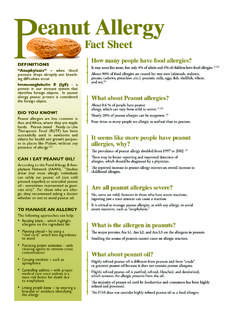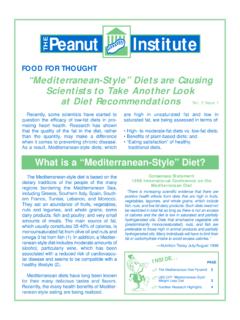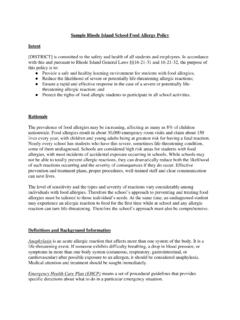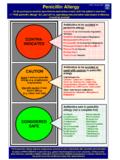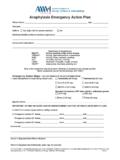Transcription of Peanut Allergy - The Peanut Institute
1 Peanut White Paper Allergy Table of Contents Executive Summary .. 1. Introduction .. 2. Peanut Allergy .. 2. Peanut Oil .. 5. Resources .. 6. References .. 7. Executive Summary awareness to provide KEY FACTS advocacy and education, The data shows that - of to advance research people have a mild to more severe on behalf of all those tree nut Allergy The focus of this white paper is to present the current science affected by food allergies The aroma of peanuts cannot on Peanut Allergy , while placing it in the context of food and anaphylaxis, and to cause allergic reactions Allergy overall. About four percent of adults and four percent help individual families Peanut oil, when highly refined, does not cause allergies in those of children have food allergies.
2 In children under five years of cope with their child's allergic to peanuts age, food Allergy can approach six to eight percent. Just over food allergies in order to The vast majority of Peanut oil one percent of this is due to peanuts and tree nuts, with half keep children safe. used in the United States is highly refined having an Allergy to peanuts and half to tree nuts. The reported increase in Peanut Allergy parallels an overall increase in According to the FAAN, It is estimated that the number of deaths from all food Allergy in childhood allergic disease. Studies show that most general is about 150 per year allergic individuals can Proper management of Peanut An allergic reaction to peanuts can vary from mild to safely eat Peanut oil (not Allergy is encouraged and can be severe.)
3 Severe reactions can lead to anaphylaxis, which is a cold pressed, expelled, highly successful potentially life-threatening reaction that can include hives, or extruded Peanut oil Proper management of Peanut al- lergy is not always carried out one nausea, and breathing difficulties. For those at risk of an - sometimes represented study showed that 50% of children anaphylactic reaction, it is essential to understand all of the as gourmet oils). For at risk of allergic reactions did not carry epinephrine with them facts surrounding self-management. Education about Allergy those who are allergic, While promising new research risks and good management practices should be encouraged they recommend asking shows potential strategies to combat and widespread.
4 The doctor whether or not Peanut Allergy , avoiding contact with Peanut products continues to be to avoid Peanut oil. The allergic components in peanuts are specific identified the best practice for prevention of Peanut -allergic reactions. proteins. There is a misconception regarding the allergenicity of There is promising new Peanut oil. The vast majority of Peanut oil used by foodservice research underway to find new therapies for combating Peanut and by many consumers is highly refined and processed oil, Allergy . One of these therapies is called oral immunotherapy from which all of these proteins are removed. According to (See Latest Research insert), in which increasing levels of the Food and Drug Administration (FDA) Food Allergen Peanut allergen are fed in a controlled research setting.
5 Labeling and Consumer Protection Act of 2004, highly refined oils, which have been refined, bleached, and deodorized are Although this strategy is still experimental, it has been shown exempted as major food allergens. If an allergic individual is to be effective in a new study published in 2009 in the journal, unsure as to whether a product contains or was fried in highly Allergy . It is not clear whether this treatment approach refined Peanut oil, that individual should ask the manufacturer promotes a long term tolerance to the Peanut allergen, or if or restaurant for clarification. subjects are desensitized to the allergen only if they continue daily treatment. The Food Allergy & Anaphylaxis Network (FAAN) is a nonprofit organization whose mission is to raise public Until more testing has confirmed a solution, there are many helpful strategies for successful management of Peanut LATEST RESEARCH Allergy that include good hygiene and cleaning practices in A new study in Peanut allergic children that was recently published foodservice areas, education, planning ahead, and carrying in the journal, Allergy , describes a process that has been shown to medicine such as epinephrine.
6 However, for a Peanut allergic stop their allergic reactions to peanuts. Small daily doses of Peanut person, the best recommendation is to avoid contact with flour were given to Peanut allergic children over a number of weeks. All of the subjects, including one who had a severe reaction during Peanut products. the testing phase of the study, were successfully desensitized to the Peanut allergen. The therapy, called oral immunotherapy, expanded Concern over peanuts in public places has led to some schools the childrens' tolerance. So much so, that the children could eat up calling for Peanut bans. However, bans, which can never be to 10 peanuts many more than they would ingest accidentally. This fully enforced, may lead to a false sense of security and put data is especially promising, since it was effective for all of the children in the child at greater risk.
7 There is no evidence supporting the the study. However, it was con- effectiveness of this practice. A more effective solution is to ducted in a research setting and educate students, schools, and foodservice professionals and set should never be tried at home. up a food Allergy management plan. Note: This white paper provides an overview of major highlights related to food and nut allergies. We understand and respect the fact that there is a minute percentage of the population that has Peanut Allergy . We support the recommendation that Peanut -allergic individuals work with physicians to manage and minimize their risk and that the best solution at this time is avoidance of all Peanut and nut products for those who are Peanut body of scientific research in this field is rapidly emerging and we hope that there are additional solutions available to treat Peanut Allergy in the future.
8 This summary will be updated periodically to reflect 1 the latest research and statistics and any changes in the environment of Peanut -allergic individuals. When it comes to school Peanut bans, FAAN does not advocate It is also important to recognize that food intolerances are not them. They recommend parents, doctors and school officials food allergies. Food intolerance is a digestive system response work together to develop a plan that best fits their situation. rather than an immune system response and can occur when a food is improperly digested. Symptoms take longer to appear, whereas allergic reactions are usually immediate. Introduction For example, some people lack the enzyme needed to digest lactose found in dairy products.
9 This inability to digest is called lactose intolerance. Reactions to the wheat protein, gluten, is another example. An allergic reaction is caused by a dysfunction in the immune system, whether it is an allergic reaction to food, a bee sting, Peanut Allergy or to latex. With food Allergy , a constituent or ingredient (oftentimes a protein) in the food is considered an invader by the immune system and the body reacts like it is fighting to remove it. About four percent of adults and four percent of children 18 years of age or under have food allergies, with a slightly higher percentage in children under 5 years old. (1,2). A. Prevalence Fortunately, some of these allergies can be outgrown over time. With increasing news coverage on Peanut Allergy in the past few years, there may be a misperception that there is a The Centers for Disease Control and Prevention (CDC) high incidence of Peanut Allergy in the and worldwide.
10 Reports that children with food Allergy are more likely to have However, the numbers show that only - of people asthma or other allergic conditions. (2) Nearly 90 percent of have a mild to more severe Peanut Allergy , (1,3,4) and studies food allergies are caused by these common foods: tree nuts show that about 20% of Peanut allergies can be outgrown. (5). (almonds, walnuts, pecans, cashews, pistachios, etc.), peanuts, By comparison, about four times as many people are allergic milk, eggs, fish, shellfish, wheat, and soy.(3) to seafood. As with all allergies, those with a family history of Allergy , asthma, or eczema, may be at increased risk. Most allergic reactions are not life threatening, but some can lead to a more severe reaction known as anaphylaxis, The National Institute of Allergy and Infectious Disease where blood pressure drops abruptly and the airways and (NIAID) reports that approximately one in 90 people in the throat swell, which leads to breathing difficulties.

